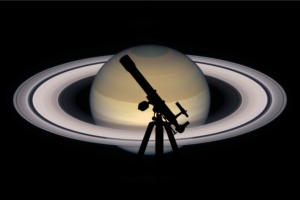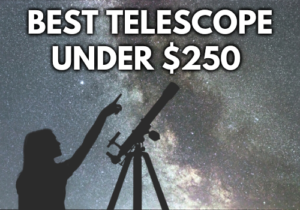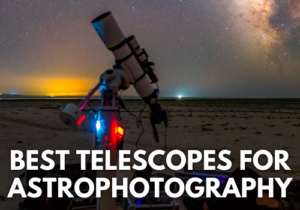
Best Telescope For Deep Space 2025; Reviews
Disclosure: This post contains affiliate links and I may earn a small commission (at no extra cost to you) if you click through and make a purchase. Thanks in advance – I really appreciate it!
Here in this “Best Telescope For Deep Space” article we’ve rounded up 8 of the best telescopes of various types, specifications, and budget. Below, you’ll find in-depth reviews of each, as well as an elaborate guide on what you should look for in a best telescope for DSOs.
COMPARISON TABLE
| Image | Title | Best For | Features | Price | Buy |
|---|---|---|---|---|---|
Top Top
Top
Top
Top Top
Top
Top
Top | Celestron - NexStar 8SE | Best Overall | Type: Schmidt Cassegrain, Aperture: 203 mm (8″), Focal length: 2032mm, Focal Ratio: f/10 | See on Amazon | |
 Top
Top
Top
Top
Top
Top | Celestron - 114LCM | Best For Beginners | Type: Reflector, Aperture: 114 mm(4.5″), Focal length: 1000mm, Focal Ratio: f/8.8 | See on Amazon | |
 Top
Top
Top
Top
Top
Top | Orion 8945 8 inch Dobsonian | Best Budget Pick | Type: Reflector, Aperture: 203mm (8”), Focal length: 1250mm, Focal Ratio: f/5.9 | See on Amazon | |
 Top
Top
Top
Top
Top
Top | Celestron CPC 1100 | Best 11 inch | Type: Schmidt-Cassegrain, Aperture: 280 mm (11”), Focal length: 2800mm, Focal Ratio: f/10 | See on Amazon | |
 Top
Top
Top
Top
Top
Top | SkyWatcher Flextube 250 SynScan Dobsonian 10-inch | Best Dobsonian | Type: Newtonian Reflector, Aperture: 254mm (10″), Focal length: 1200mm, Focal Ratio: f/4.7 | See on Amazon | |
 Top
Top
Top
Top
Top
Top | EqOrion 09007 SpaceProbe 130ST | Best Reflector | Type: Reflector, Aperture: 130 mm(5.1″), Focal length: 650mm, Focal Ratio: f/5 | See on Amazon | |
 Top
Top
Top
Top
Top
Top | Orion 9823 Apex 102mm Maksutov-Cassegrain | Best For DSLR Astrophotography | Type: Maksutov-Cassegrain, Aperture: 102mm (4″), Focal length: 1300mm, Focal Ratio: f/12.7 | See on Amazon | |
 Top
Top
Top
Top
Top
Top | Celestron NexStar Evolution Telescope | Best For Professionals | Type: Schmidt-Cassegrain, Aperture: 203 mm (8”), Focal length: 2032mm, Focal Ratio: f/10 | See on Amazon |
Product prices and availability are accurate as of the date/time indicated and are subject to change. Any price and availability information displayed on [relevant Amazon Site(s), as applicable] at the time of purchase will apply to the purchase of this product.
Prices pulled from the Amazon Product Advertising API on:How did we choose the best telescope for deep space viewing?
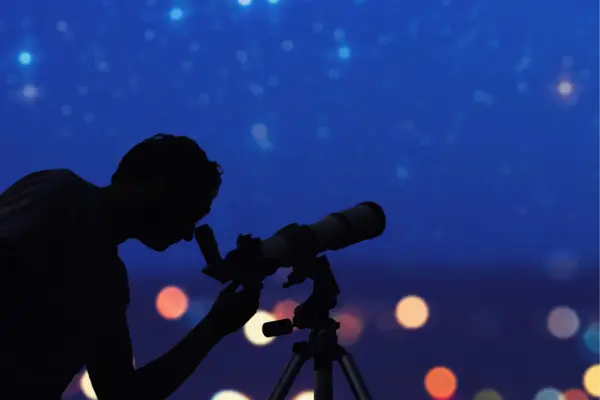
There are two most important things that you need in a telescope for deep space viewing – a) maximum light gathering ability i.e a wide aperture and b) to resolve the gathered light as finely as possible with amazing optics configuration.
When it comes to deep space viewing telescopes, decent size aperture definitely should be the top priority. The more aperture you have, the more light you can collect. The more light you collect, the fainter an object you can see.
To ensure we can provide you with all the information about the best telescope for DSOs, we spent multiple hours researching and going through customer’s reviews and telescope specifications. We consulted 2 experts and a few of our in-house astronomy enthusiasts and came up with certain popular criteria that are a must for a good deep space telescope.
For deep space astronomy a Newtonian Reflector is always a great choice. Typically, you’ll get the most bang for your buck in terms of dollar per inch of aperture.
For the shortlisted Newtonian reflectors, focal length is another factor that we looked at.
Another popular design is the Schmidt Cassegrain telescope. Again, these types of telescopes tend to be affordable in large sizes (though, less so than a Newtonian). Typically, however, they have long focal lengths, and a reducer/corrector might be desirable to achieve a wider field of view.
The night sky has so many deep space objects to offer. We are sure that our guide will help you find the best telescope for deep space viewing and will help you see all these faint stars, clusters and nebulae, as well as suit your lifestyle.
Best Telescope For Deep Space
With so many models and characteristics any modern telescope has, it becomes rather hard for both novices and pros to find the one We have analyzed the features that make the best telescope to help you pick out the one that is most suited to you.
Best Overall
Celestron – NexStar 8SE
- Type: Schmidt Cassegrain
- Aperture: 203 mm (8″)
- Focal length: 2032mm
- Focal Ratio: f/10
- Mount: GoTo Alt-Azimuth
- Eyepiece: 25mm
- Magnification: 81x
- Weight: 33 lbs.(15 kg)
- Our Rating: 9.6/10
Prices pulled from the Amazon Product Advertising API on:
Product prices and availability are accurate as of the date/time indicated and are subject to change. Any price and availability information displayed on [relevant Amazon Site(s), as applicable] at the time of purchase will apply to the purchase of this product.
The NexStar 8SE is an 8-inch Schmidt-Cassegrain with a focal length of 2,032mm, giving a focal ratio of f/10. All of this fits into a compact orange tube that is just 432mm long.
Click here to read Celestron NexStar 8SE’s full review
A StarPointer red-dot finder, E-Lux 25mm, 1.25-inch fit Plössl eyepiece and a star diagonal complete the optical tube assembly.
It is ideal for beginners and upgraders who want a huge aperture, easy goto set-up, a 40,000 object database and motorised tracking all for a relatively low price.
The NexStar 8SE has a long Vixen dovetail bar on the side of the optical tube, but it is largely decorative in purpose as the scope will only really balance with the dovetail slid all the way or nearly all the way forward in the saddle.
On average it takes a new telescope user approximately 5 minutes to do a full sky alignment with this telescope.
Once aligned the Celestron 8 SE computerized telescope is incredibly easy to operate. Optically the Celestron NexStar 8 SE telescope is nearly flawless with Celestron’s famous C8 Optical Tube Assembly.
The 8SE is one of the best telescope for deep space astronomy as it helps you easily view those faint deep sky objects such as nebulae, star clusters and galaxies.
This Celestron telescope yields super crisp images of the night sky and, once aligned, finds objects with complete accuracy.
It’s mount is a single-arm, altazimuth mount, all-in-one unit with the neatly integrated NexStar hand controller, which can be pulled out when in use.
The NexStar computerised hand controller has been designed to slot into the single arm and provides a database of 40,000 objects to choose from.
The NexStar 8SE has a long Vixen dovetail bar on the side of the optical tube, but it is largely decorative in purpose as the scope will only really balance with the dovetail slid all the way or nearly all the way forward in the saddle.
Its build quality is robust and it can take the general knocking around that comes with usage of a telescope.
Setting it up is quite easy too, just follow the manual. Takedown is just as quick and the whole scope packs away into rather small dimensions – certainly small enough for the average trunk.
The 8SE mount takes eight AA batteries, but we recommend only using these as backup – get a portable 12-volt DC power supply and cord or Celestron even sells some as the PowerTank meant specifically for astronomical use.
Pros:
- Excellent optics
- Easy computerized GoTo tracking
- Light, portable and affordable
- Easy setup and takedown
- Good value for money
Cons:
- Plastic accessories
- Short battery life
Best For Beginners
Celestron – 114LCM
- Type: Reflector
- Aperture: 114 mm(4.5″)
- Focal length: 1000mm
- Focal Ratio: f/8.8
- Mount: Motorized; Alt-Azimuth
- Eyepiece: 25mm
- Magnification: 40x
- Weight: 15 lbs. (6.80 kg)
- Our Rating: 9/10
Prices pulled from the Amazon Product Advertising API on:
Product prices and availability are accurate as of the date/time indicated and are subject to change. Any price and availability information displayed on [relevant Amazon Site(s), as applicable] at the time of purchase will apply to the purchase of this product.
The Celestron 114LCM 114mm f/9 Computerized GoTo Reflector Telescope features a 114mm diameter parabolic primary mirror that is coated with highly-reflective aluminum to allow for detailed observation of the Moon and planets, with the ability to reach outside our solar system and view binary stars, clusters, galaxies, and nebulae.
The 114LCM consists of an optical tube with a 4.5-inch mirror and a focal length of 1000mm giving a focal ratio of f/9. It has a basic rack and pinion focuser that takes 1.25-inch eyepieces: 25mm and 9mm eyepieces are provided giving magnifications of 40x and 111x.
The Celestron 114LCM has over three and a half times the light gathering capacity of a typical 60mm starter scope. That means visibly brighter deep space images and the ability to see many more faint objects than a 60mm scope could ever hope to show.
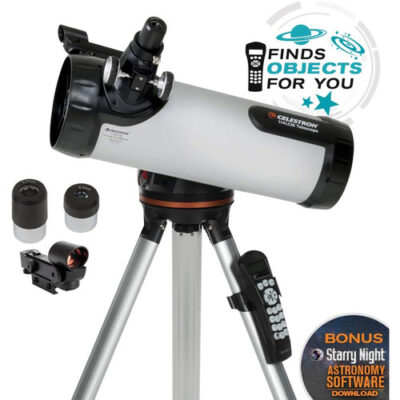
It has 90% more resolution than a 60mm scope as well, to let you see more sharper and detailed views of the Moon, planets, binary stars, and star clusters.
A built-in StarPointer red dot finder helps to aim the telescope, especially during the alignment phase.
The tube is attached to the motorised base via a Vixen-style mounting bar that connects to the aluminium tripod using a bolt on the underside.
The Celestron 114 LCM is one of the best budget computerized Celestron telescopes for viewing planets and galaxies and it comes with a standard StarPointer red dot finder and an extremely short orange anodized aluminum Vixen style dovetail.
The NexStar+ LCM hand controller lets you control, align and operate the telescope. It has a database of 4,000 targets including Solar System, Messier, NGC and Caldwell objects, along with double stars, variable stars and more.
The telescope features a single fork arm altazimuth design with pre-installed enclosed dual DC servo motor drives.
A compartment in the drive base accepts eight user-supplied AA batteries for powering the telescope. An optional AC adapter and rechargeable battery pack are available to conserve battery life.
The preassembled tripod has aluminum legs to damp vibrations quickly. The center leg brace holds a convenient no-tool quick-release accessory tray to keep your eyepieces and accessories.
Pros:
- Beginner friendly GoTo telescope
- Decent optics
- Free download of astronomy software programs for an interactive sky simulation
- Multiple accessories
Cons:
- Weak battery life
- Calibration can take some time
Best Budget Telescope For Deep Space
Orion 8945 SkyQuest XT8
- Type: Newtonian Reflector
- Aperture: 203 mm (8″)
- Focal length: 1200mm
- Focal Ratio: f/5.9
- Mount: Dobsonian
- Eyepiece: 25mm
- Magnification: 48x
- Weight: 41.0 lbs.(18.5 kg)
- Our Rating: 9.4/10
Prices pulled from the Amazon Product Advertising API on:
Product prices and availability are accurate as of the date/time indicated and are subject to change. Any price and availability information displayed on [relevant Amazon Site(s), as applicable] at the time of purchase will apply to the purchase of this product.
The Orion XT8 dobsonian is a mid-range dobsonian reflector telescope. For many amateur astronomers who are just getting started, dobsonian reflector telescopes are a popular choice.
The XT8 features an 8″ (203mm) primary mirror. With a focal length of 1200mm, this gives a focal ratio of f/5.9.
Advanced observers will enjoy the XT8’s 2″ Crayford focuser, which allows for larger eyepieces, or even a “T” adapter for short-exposure astrophotography.
Amateur astronomers will find the included 2″ to 1.25″ eyepiece adapter allows the use of 1.25″ eyepieces with no aberrations.
The telescope has enough light grasp to pull in pleasing views of deep space objects such as nebulas, galaxies and star clusters.
The XT8 is a family-friendly telescope, allowing children to enjoy the fascinating hobby of stargazing or bird watching and letting them follow their passion of amateur astronomy.
Setting up the SkyQuest XT8 is fairly easy – the telescope comes in two detachable parts, which need to be connected by the integrated springs.
The easy-to-use finder and optical tube allows viewing of most extra-terrestrial objects like star clusters and even obscure matter such as nebulae, even in an area with a high concentration of light pollution.
The 25mm Plossl eyepiece comes in handy for any amateur astronomer.
It’s 46” long steel-covered tube slides effortlessly on the Dobsonian base, allowing viewers to get into the observing pocket in no time.
It can also be pitched and rotated for an even more versatile and varied way of gazing into the night sky.
The telescope’s box contains everything an amateur might need to start exploring the skies and learn more about our galaxy.
The XT8 is one of the best telescopes for beginners that can last a lifetime for an amateur astronomer or the whole family.
Pros:
- Large aperture for a low price
- 203mm primary mirror allows users to spot nebulae in minute details
- Perfect for kids age 12 or higher. It’s not complicated to set up or use
- Has a sturdy base and CorrecTension springs allow enough resistance, so the telescope stays upright.
Cons:
- Needs more eyepieces to be utilized to its full potential
- Red dot finder is of limited utility
Related
Best 11-Inch Telescope
Celestron CPC 1100
- Type: Schmidt-Cassegrain
- Aperture: 280 mm (11”)
- Focal length: 2800mm
- Focal Ratio: f/10
- Mount: GoTo: Alt-Azimuth
- Eyepiece: 40mm
- Magnification: 70x
- Weight: 92 lbs.(42 kg)
- Our Rating: 9.4/10
Prices pulled from the Amazon Product Advertising API on:
Product prices and availability are accurate as of the date/time indicated and are subject to change. Any price and availability information displayed on [relevant Amazon Site(s), as applicable] at the time of purchase will apply to the purchase of this product.
Deep-sky objects are typically faint, so ‘light-bucket’ scopes with a low-power eyepiece tend to give the best views.
The brighter planets and the Moon offer plenty of light, so the emphasis here tends to be about getting sufficient magnification to be able to see intricate surface detail.
The new CPC 1100 from Celestron is a good scope for both.
Its generous 11 inches of aperture gathers plenty of light from nebulae and galaxies, while its focal length is long enough to get really detailed views of bright Solar System objects with a modest set of eyepieces.
The CPC 1100 with its wide aperture is one of the best telescope for deep space and planets.
The CPC 1100 takes full advantage of its vast database of thousands of NGC and Abell galaxies as well as delivering a new level of detail to all your favorite deep sky objects.
This CPC 1100 features Celestron’s premium StarBright XLT coatings and has a built-in 16-channel GPS.
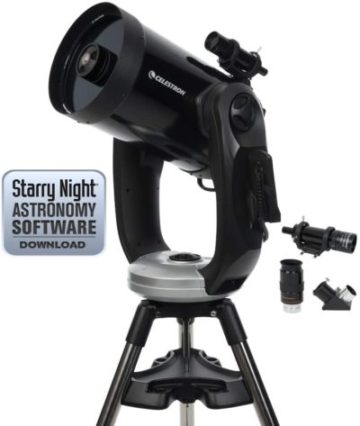
With sophisticated software features like Hibernate function, the CPC can maintain its star alignment night after night without needing to be realigned, making it an ideal instrument for a permanent observatory facility.
The CPC 11 XLT is surprisingly portable for an 11″ scope. Taking it to the dark sky observing site it needs to get the most out of its large aperture optics is easy, even for a single individual.
With high transmission XLT multi coatings and a light grasp almost 1600 times that of even the sharpest dark-adapted eye, the CPC 11 XLT can reveal to you faint star clusters, nebulas, planets, and galaxies in amazing detail.
The CPC 11 XLT is perhaps the ultimate large aperture fork mounted portable personal telescope, ideal not only for lunar, planetary, and deep space visual observing, but for DSLR astrophotography and CCD imaging as well.
Pros:
- Great optics that give superb viewing and photographing performance.
- Hassle-free GPS alignment and Auto-Guider.
- Telescope looks premium because of the Starbright XLT coatings
- Contains a heavy duty tripod which makes longer periods more comfortable
- The telescope sports an ergonomic design that is easy to transport from one location to another
Cons:
- Finder scope is average but not so much helpful
- Focus knob does not rotate easily and needs force
Best Dobsonian For Deep Space
Sky-Watcher Flextube 250
- Type: Newtonian Reflector
- Aperture: 254mm (10″)
- Focal length: 1200mm
- Focal Ratio: f/4.7
- Eyepiece: 25mm, 10mm
- Magnification: 36x, 91x
- Weight: 72.0 lbs. (32.7 kg)
- Our Rating: 9.8/10
Prices pulled from the Amazon Product Advertising API on:
Product prices and availability are accurate as of the date/time indicated and are subject to change. Any price and availability information displayed on [relevant Amazon Site(s), as applicable] at the time of purchase will apply to the purchase of this product.
The SkyWatcher’s 10” mirror delves deep into the universe, allowing you to see thousands of deep space objects from Saturn, Jupiter, & Mars to galaxies, nebulae and star clusters millions of light years away.
This collapsible telescope features a patented truss tube system that enables the front corrector plate/eyepiece assembly to be moved back and locked against the main rear tube to reduce the size for storage and transportation.
The included SynScan computerized hand control is the brain behind the Sky-Watcher GoTo Dobsonian.
It allows you to point your telescope at a specific object, or even tour the night sky at the touch of a button!
With an internal database of more than 42,000 celestial objects, this easy-to-use hand control can locate any object you see in the night sky with push-button ease.
You can even let your Sky-Watcher GoTo Dobsonian take you on a tour of all the best objects based on your time and location.
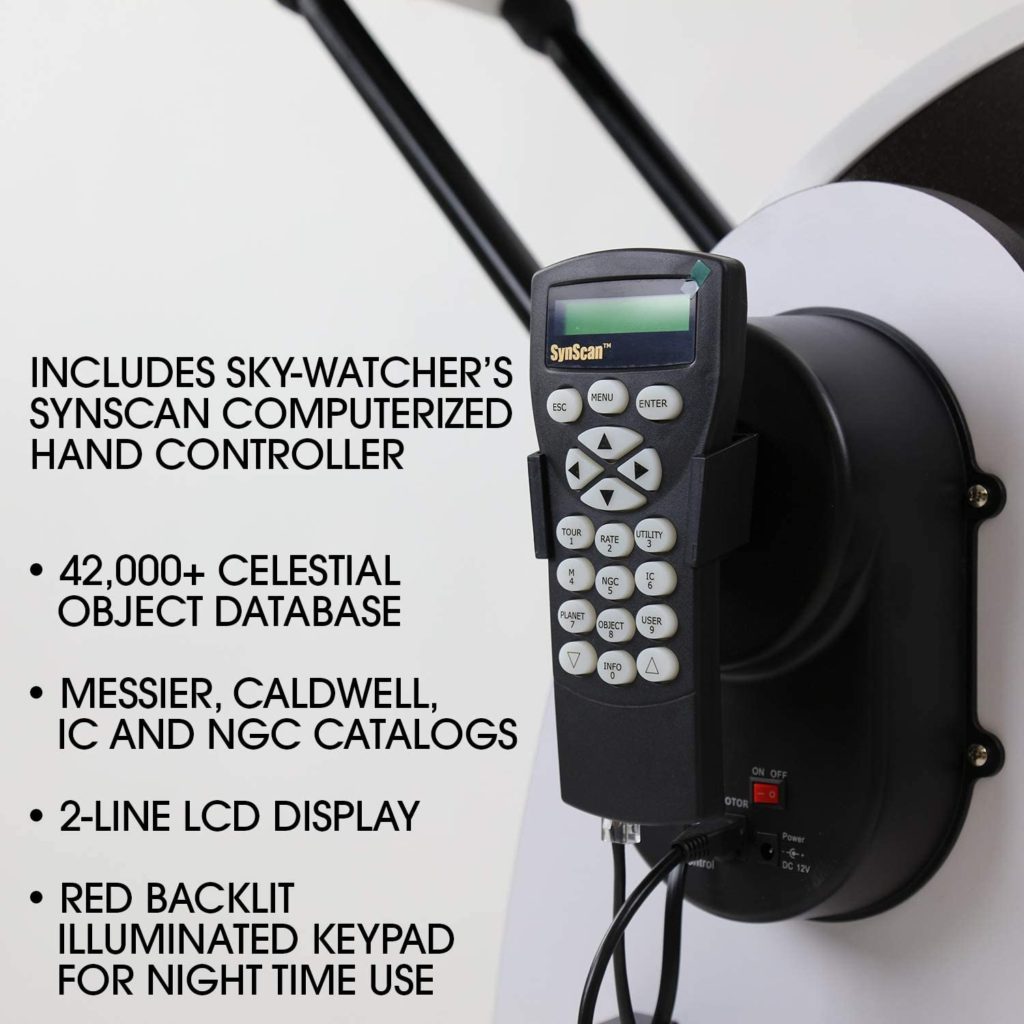
To get started, all you have to do is – perform a simple alignment procedure.
SkyWatcher S11810 GoTo Collapsible Dobsonian is one of the best telescope for deep space observation.
This Dobsonian was carefully engineered to combine ease of use, extreme portability and consistent performance in an affordable package.
No doubt, there are other truss tube designs, but the Sky-Watcher Collapsible Dobsonian does not need to be disassembled between uses.
It transports as two compact pieces that can be assembled, collimated easily and ready to use in just seconds.
Pros:
- Collapsible truss tube design for maximum portability
- 2” Crayford focuser with 1.25” adapter that can be used with either size telescope eyepieces
- Comes with with 42,000 object database and simple alignment procedure
Cons:
- A little on the heavier side
Best Reflector
Orion 09007 SpaceProbe 130ST
- Type: Reflector
- Aperture: 130 mm(5.1″)
- Focal length: 650mm
- Focal Ratio: f/5
- Mount: Equatorial
- Eyepiece: 25mm, 10mm
- Magnification: 26x, 65x
- Weight: 24.2 lbs.(11 kg)
- Our Rating: 9/10
Prices pulled from the Amazon Product Advertising API on:
Product prices and availability are accurate as of the date/time indicated and are subject to change. Any price and availability information displayed on [relevant Amazon Site(s), as applicable] at the time of purchase will apply to the purchase of this product.
The Orion SpaceProbe 130ST Newtonian Reflector is an excellent and one of the best telescopes for deep space viewing. It is well-suited for both beginners as well as intermediate stargazers.
The SpaceProbe 130ST is a 130mm f/5 Newtonian reflector telescope.
This 5.1″ aperture reflector telescope gathers an ample amount of light for great views of the planets and Moon, as well as brighter galaxies, nebulas, and star clusters
The telescope also comes with tools to help you assemble the product, and two eyepieces: 10mm for 65x, and a 25mm for 26x magnification, respectively.
The quick set-up and ease of use makes the SpaceProbe 130ST EQ a very versatile telescope which the whole family can enjoy.
This Orion space probe telescope also boasts a short 24″ long optical tube design which enhances its portability, while the 130mm optical diameter, and the 650mm focal length are in perfect balance with the f/5.0 focal ratio.
In addition, it possesses design features, such as a parabolic mirror and a specially designed holder for the secondary mirror, that focus the light captured by the aperture and use it to sharpen the images produced by the scope, even with its shorter tube.
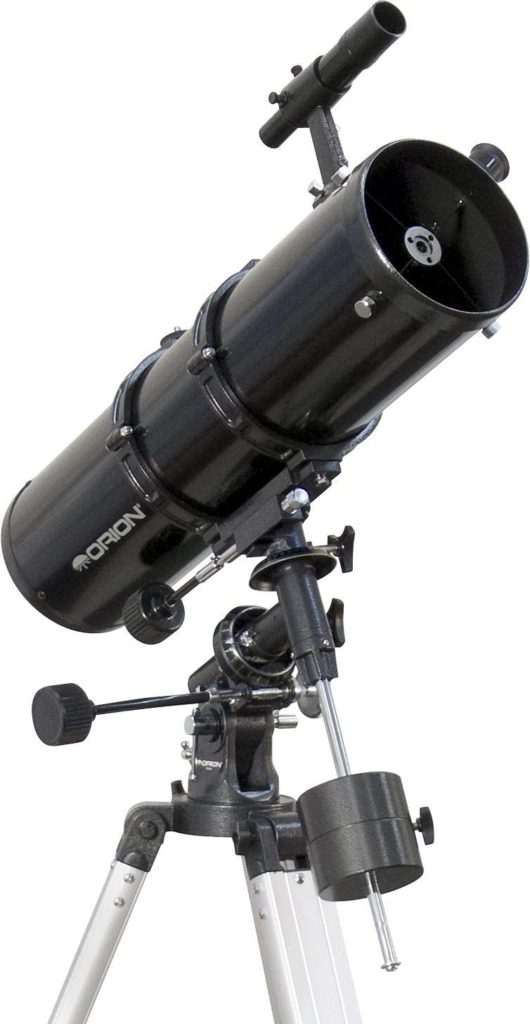
The included aluminium tripod is very sturdy, and also includes an accessory tray that can be very useful when you are outdoors in the dark and need a place to organize your accessories neatly.
The equatorial mount is perfectly built and allows manual slow-motion tracking of celestial objects as they move across the sky.
The mount can also be upgraded at a later time to a motorized option that tracks objects automatically, so that’s a nice option to have and definitely a plus if you are using the Orion SpaceProbe 130ST for astrophotography.
Just like many other similar products, the Orion 09007 also comes with Orion’s Starry Night software, which is very useful for beginners, and has the added benefit of alerting the user of upcoming celestial events.
Short 24″ long optical tube design for easy portability and fast f/5 focal ratio for pleasing wide-field performance makes the SpaceProbe 130ST EQ a very versatile telescope the whole family can enjoy.
Pros:
- Nice set of accessories
- Can be upgraded to have motorized tracking
- Comes with an Equatorial mount and a versatile tripod
- Easy to assemble and transport
Cons:
- Plastic focuser and mount parts
- Somewhat confusing instructions
Best For DSLR Astrophotography
Orion 9823 Apex
- Type: Maksutov-Cassegrain
- Aperture: 102mm (4″)
- Focal length: 1300mm
- Focal Ratio: f/12.7
- Mount: OTA
- Eyepiece: 25mm
- Magnification: 52x
- Weight: 5 lbs (2.26 kg)
- Our Rating: 9/10
Prices pulled from the Amazon Product Advertising API on:
Product prices and availability are accurate as of the date/time indicated and are subject to change. Any price and availability information displayed on [relevant Amazon Site(s), as applicable] at the time of purchase will apply to the purchase of this product.
The Orion Apex 102mm Maksutov-Cassegrain Telescope exhibits all the performance of classic long-tube 102mm refractors, and easily outperforms smaller refractors on views of the planets and Moon as well as on faint nebulae and star clusters.
Its long focal length allows high-power study of Jupiter’s cloud belts and Red Spot, and Saturn’s rings, and provides long reach for capturing distant terrestrial targets.
The Apex 127 focuses with the same moving-mirror system most catadioptrics use, and comes with a Maksutov-thread visual back, though you can buy an adapter to use Schmidt-Cassegrain threaded accessories.
The 1.25” visual back included has built-in T-threads to attach your DSLR camera. Attaching an SCT-thread adapter and a 2” SCT diagonal will result in some vignetting with wide-field eyepieces thanks to the scope’s narrow baffle tube and undersized primary mirror, but you can still use them to some extent.
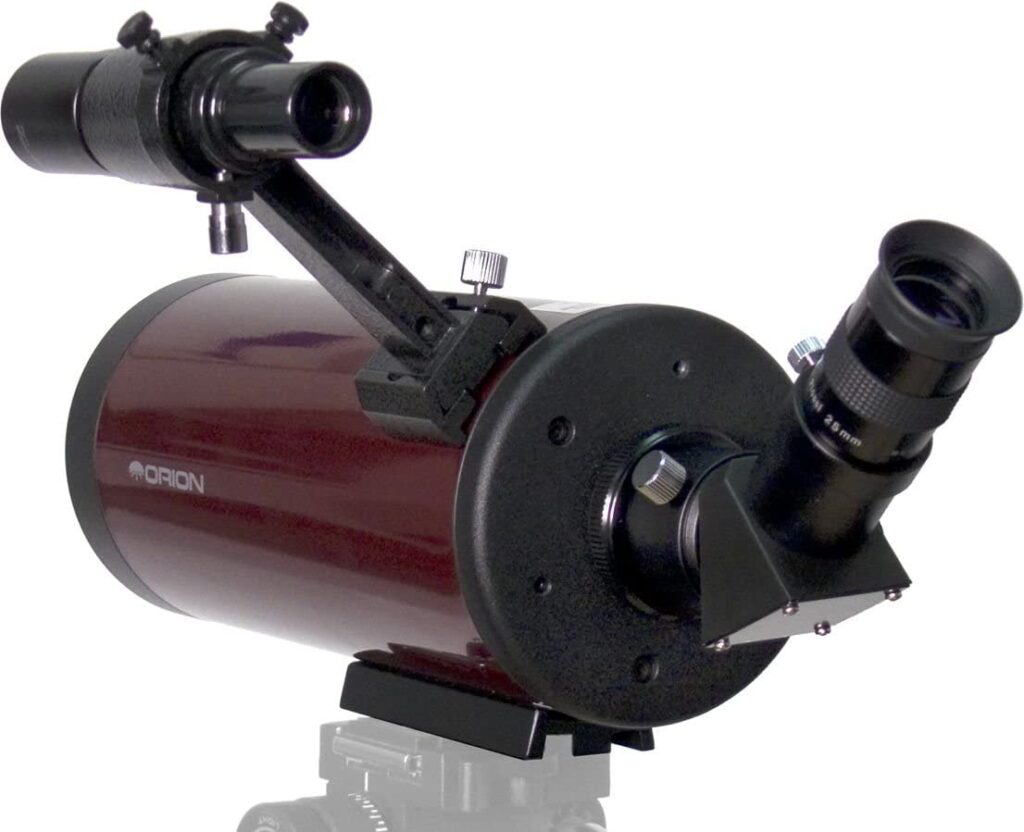
Like most telescope optical tubes, the Apex 127 has a Vixen-style dovetail bar with ¼ 20 holes attached so you can either attach it to a Vixen-compatible mount or a heavy-duty photo tripod.
Speaking of accessories, the Apex 102mm comes with a multi-coated 25mm Sirius Plossl telescope eyepiece (1.25″) and a 45° diagonal that provides a correctly-oriented field of view. As does the correct-image finder scope (6×26 on Apex 102), which makes locating objects a cinch.
The StarMax 127 does do a pretty good job for lunar and planetary astrophotography. With a 2x Barlow, a mount with motorized tracking, and a webcam-style CCD like the ZWO ASI120 or a Celestron NexImage series camera, you can get high-resolution images of the Moon and planets.
Pros:
- Great optics
- Can also be used as a spotting scope
- Extremely portable
- Versatile
- Comes with a carry bag
Cons:
- Requires a heavy duty mount
Best For Professionals
Celestron – NexStar Evolution
- Type: Schmidt-Cassegrain
- Aperture: 203 mm (8”)
- Focal length: 2032mm
- Focal Ratio: f/10
- Mount: GoTo: Alt-Azimuth
- Eyepiece: 40mm, 12.5 mm
- Magnification: 51x, 156x
- Weight: 40 lbs.(18.2 kg)
- Our Rating: 9.2/10
Prices pulled from the Amazon Product Advertising API on:
Product prices and availability are accurate as of the date/time indicated and are subject to change. Any price and availability information displayed on [relevant Amazon Site(s), as applicable] at the time of purchase will apply to the purchase of this product.
The Celestron NexStar Evolution 8 Computerised Cassegrain telescope is a large Schmidt Cassegrain. It has a massive 203.2mm (8″ aperture) and 2032mm focal length.
With these specifications, this telescope is capable of reaching high magnifications of 480x ( highest practical magnification according to Celestron) is perfect for viewing planets and deep space objects.
Its Alt-az mount sits on a stainless steel tripod and comes with a star diagonal, Celestron’s StarPointer red-dot finderscope, 40mm and 13mm eyepieces, and a mains power cable.
The mount is fully computerised and can be controlled either by the supplied handbox / hand controller, or by a smartphone / tablet that connects via the mount’s built-in WiFi, using Celestron’s SkyPortal app, available in App Store or Google Play.
The telescope has a focal ratio of f/10, making the focal length 2000mm. This is a very long FL for such a small telescope and is a great feature for deep space observation.
The Evolution mount also features a built-in rechargeable lithium-ion battery, which will power the telescope all night. This is recharged using the provided power adapter.
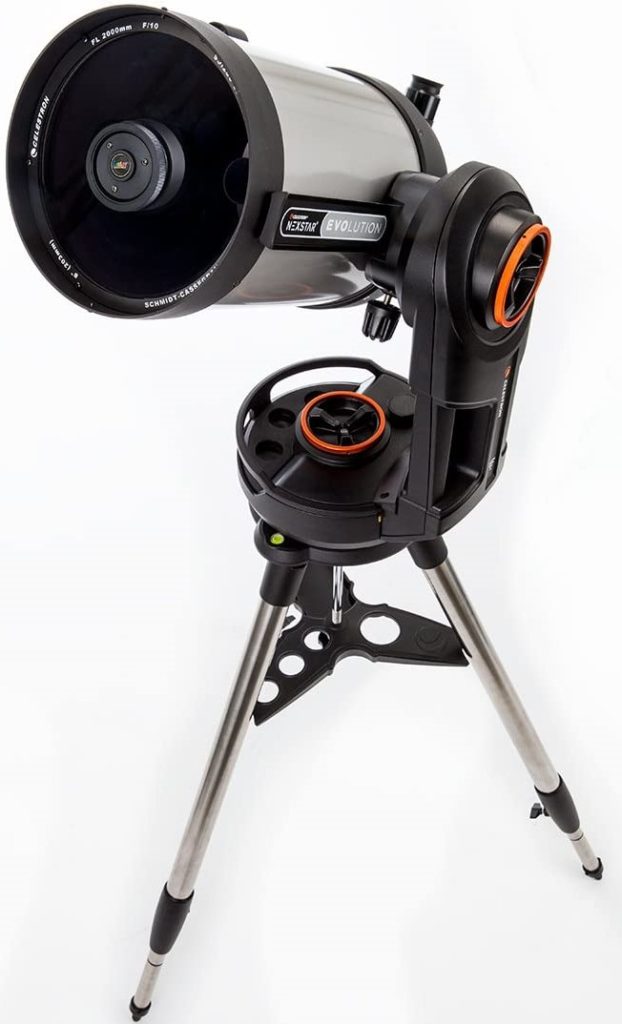
The Nexstar+ hand controller includes over 40,000 objects in its database, an internal time clock which means that you do not have to enter the time and date every time you start up the mount if you choose to enable it.
The pointing accuracy of the mount after a 3-star alignment is also excellent. The controller includes 9 slew rates for intricate and accurate slewing and pointing which means you can go from rate 9, which moves the mount several degrees per second to 1, moving at half the speed of the stars.
The Celestron NexStar Evolution Telescope is designed to be controlled by the Celestron SkyPortal App.
The SkyPortal app is an amazing feature as it allows you to control the NexStar Evolution from your Android or Apple device. The SkyPortal uses an intuitive planetarium interface that offers a real time display of the celestial objects that are visible at the exact time you are out with your telescope.
SkyPortal also educates users with enhanced audio functionality that offers the history and science behind hundreds of the most popular celestial objects.
Pros:
- Robust mount & sturdy tripod
- Portable form of the telescope
- Amazing app & control software
- Excellent optics
Cons:
- Alt-az mount might not be good for astrophotography
Deep Space Observation Guide
A beginner’s guide to viewing the faint objects of the distant cosmos.
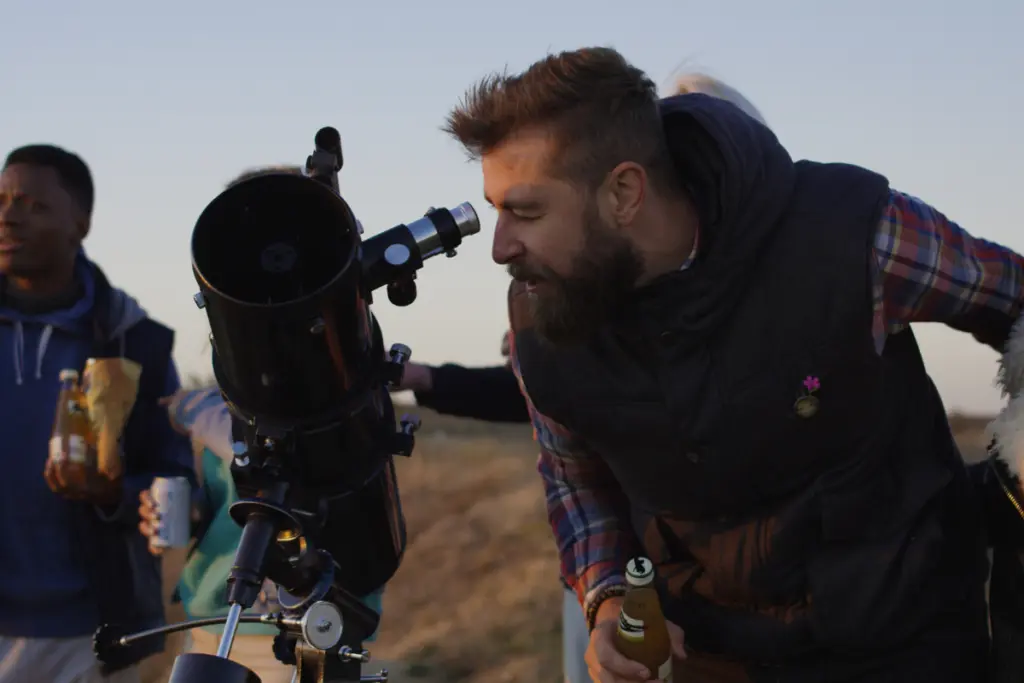
Why GoTo Mounts Are The Best For Deep Space Observations
GoTo mounts can be very helpful in locating deep space objects as these are generally small and dim and not easy to track down.
After being calibrated for your sky, GoTo mounts can locate objects that are difficult, if not impossible, to spot with the naked eye, even under light-polluted city skies.
With a computerized GoTo mount that is able to track the motion of the stars, the telescope you attach to it is up to you. Not only does a GoTo telescope mount make locating objects in the night sky easier, but it also allows you to take long-exposure images.
A GoTo telescope is essential if you wish to capture images of objects, either with your smartphone, or by mounting a DSLR camera to the telescope.
A GoTo telescope can help you learn the sky, too. Using a simple star chart or your astronomy app as a starting reference, you can use your telescope to observe all the major stars and deep space objects such as nebulas, star clusters, galaxies, etc. in a given constellation. Or you can simply wander around the sky.
All GoTo models have a handheld control pad with buttons for moving the telescope and for selecting objects, and most also feature an illuminated readout to tell you where the telescope is pointed and give you deep space object information.
Eyepieces For Deep Space Observation
Most telescope manufacturers supply one medium power eyepiece with their scopes. Its power is low enough to show you a generous field for deep space observing (but not so low that light pollution masks faint nebulas and galaxies), while still high enough for reasonably-sized planet and star cluster images.
We recommend trying a wide range of powers on any object. (A judiciously chosen, high-quality zoom eyepiece makes this a breeze.) You may be surprised by how much more you’ll see at one power than another.
Using Your Eyes To View Deep Space Objects
This may sound impossible but it’s not. Your observing options will be limited and you may have to drive somewhere dark, but it’s achievable.
The brighter the object and the darker the sky the better the object will look.
The Andromeda Galaxy (or M31, its catalogue number) and open star cluster, the Pleiades, M45, are the most observed deep-sky objects with the naked eye.
The former is best observed away from light pollution, but the Pleiades can be observed even in towns; you should be able to see a fuzzy patch with six to eight bright stars.
Other targets include the Beehive Cluster, M44, and the Hyades.
Deep Space Viewing Tips
- While low magnifications and wide fields of view are typically used for finding deep sky objects, higher magnification has the benefit of darkening the background sky — especially good for someone living in an area with light pollution
- Close doubles and tight clusters (especially globulars) are best seen on nights of steady seeing, while nebulae and galaxies should be saved for nights when transparency is excellent. All deep-sky objects are at their best when on or near the meridian and, therefore, highest in the sky.
- Use direct vision where color perception and resolution are important, and averted vision (looking slightly to one side of the object) for seeing faint details. In the latter case, a dark opaque cloth covering your head down to your shoulders will help prevent unwanted light from streetlights, cars, and the glowing sky itself from ruining your dark adaptation.
- The later at night you observe, the less light pollution you will have to contend with as the busy world around you shuts down for the night.
- Night vision also is impaired by alcohol, nicotine, and low blood sugar, so don’t drink, smoke, or go hungry while deep-sky observing.
- Night vision also is impaired by alcohol, nicotine, and low blood sugar, so don’t drink, smoke, or go hungry while deep-sky observing.
- Most importantly, be patient. If at first you don’t see anything where a star cluster, nebula, or galaxy is supposed to be, keep looking. Then look some more. You’ll be surprised at how much more of the scene glimmers into view with prolonged scrutiny.
Conclusion
The Celestron – NexStar 8SE is our pick for the overall best telescope for deep space with Schmidt-Cassegrain optics and fully computerized controls that provides outstanding performance. The telescope’s classic design, big 8″ aperture, and great features make this telescope a great choice for beginners and advanced astronomers alike.
SkyWatcher S11810 GoTo Collapsible Dobsonian is our pick for the best dobsonian telescope for deep space.
It features a large 10″ aperture parabolic mirror that captures enough light to make detailed observations of the Moon and planets, and still reach out past our solar system to discover deep space objects such as nebulae, globular clusters, and galaxies. Its f/4.7 focal ratio and Crayford focuser makes this an ideal choice for imaging. Its relatively fast focal ratio enables devices to capture images in less time than slower scopes.
The Celestron CPC 1100 is the largest aperture telescope on our list.
The CPC 1100 takes full advantage of its vast database of thousands of NGC and Abell galaxies as well as delivering a new level of detail to all your favorite deep space objects. This CPC 1100 features Celestron’s premium StarBright XLT coatings.
the Celestron CPC 1100 GPS (XLT) 280mm f/10 Schmidt-Cassegrain GoTo Telescope provides users with a complete rig for near- and deep-space observation and astrophotography.
Written by:

Chandrashekhara Rao
I grew up in a rural community with a dark sky, and that is where I learned to appreciate planets and stars at an early age. I have been fascinated with all things astronomical since I was a kid and started with a cheap-and-cheerful 60mm refractor on a wobbly tripod.
ABOUT US
We are a team of active amateur astronomers, here to help you with all your astronomy and science related needs – this is anything, from reviewing the latest telescopes to be released to talking about gravity and neurons. The Big Bang Optics was started because of our love for astronomy and to help others like us find the best telescope and accessories.
LEGAL DISCLAIMER
The Big Bang Optics is a participant in the Amazon Services LLC Associates Program, an affiliate advertising program designed to provide a means for sites to earn advertising fees by advertising and linking to Amazon.com. The Big Bang Optics also participates in affiliate programs with Clickbank and other sites. The Big Bang Optics is compensated for referring traffic and business to these companies.

